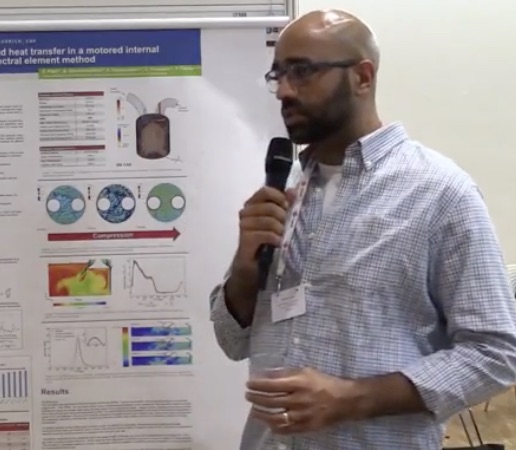 In this video from PASC18, Saumil Patel from Argonne describes his poster: A low-Mach simulation of flow and heat transfer in a motored internal combustion engine using the spectral element method.
In this video from PASC18, Saumil Patel from Argonne describes his poster: A low-Mach simulation of flow and heat transfer in a motored internal combustion engine using the spectral element method.
A proof-of-concept, wall-resolved implicit large eddy simulation (LES) campaign was performed to capture in-cylinder flow and heat transfer within an internal combustion engine (ICE). Over 20 cycles of the gas-exchange process was simulated, revealing variations in the intake jet impingement angle on the wall and piston surfaces from cycle-to-cycle. This calculation confirms a rising level of turbulent intensity during the compression stroke which is crucial to efficient engine operation.
This work marks a milestone achievement in using Nek5000, a highly-scalable computational fluid dynamics (CFD) solver, to capture turbulent flow and thermal fields inside realistic engine geometries. In the context of an arbitrary Lagrangian-Eulerian (ALE) framework, several algorithms have been developed and integrated into Nek5000 in order overcome the computational challenges associated with moving boundaries (i.e. valves and pistons).
This simulation makes use of a characteristic-based, time-stepping scheme to overcome Courant (CFL) conditions associated with standard, semiimplicit schemes. In addition, a grid-to-grid algorithm is employed to interpolate field variables from one mesh to another in order maintain spatial resolution requirements. The potential impact of this work is an unmatched, accurate, and highly-scalable tool for researchers to facilitate the efficient design of ICEs with short turn-around time.
Importance
- Increasing the efficiency of ICEs is one of the most promising and cost-effective approaches for dramatically improving the fuel economy of the on-road vehicle fleet in the near to mid-term.
- These improvements offer direct fuel cost savings to the consumer and do not require any changes to consumer driving behavior.
In addition:
- Accurate, science-based, simulations using CFD can shed light on the complex phenomena within an ICE by improving the fundamental understanding that will help to establish and characterize the physical causes of stochastic events.
- Predictive simulations were identified as an important tool in enabling increased engine efficiency [U.S. DOE – Office of Science]
- Advanced simulation of processes such as the turbulent gas-exchange process, heat transfer, and fluid interactions with the cylinder walls are critical to realizing efficient engines with greater power density.
Challenges to Simulation Thermal-hydraulic analyses inside ICEs using CFD are challenging for several reasons.
- Turbulence: Reynolds numbers are O(104), therefore requiring a large number of grid-points (O(107 -109)) to resolve the smallest eddies (i.e. Kolmogorov scale). Requires BIG computational resources (i.e. HPC machines).
- Complex Geometries: Pipe-valve stem connection are difficult to mesh with body-conforming grids, leaving analysts to use orthogonal approximations that are unable to achieve higher than second-order spatial accuracy.
- Courant number restrictions: Fast jet of air moving through the intake valve imposes very small time-steps (O(10-7) s). This is due to the large number of grid-points required to capture turbulence in the shear layers of flow of the annular jet. In some cases, this can increase the time-to-solution by 3x [Schiffman et. al 2016].
This poster was a collaboration between the following institutions:
1) Aerothermochemistry and Combustion Systems Lab (LAV) at ETH-Zürich (Switzerland) – LAV at ETH-Zürich
2) University of Illinois at Urbana-Champaign (USA)
3) Aristotle University of Thessaloniki (Greece)
4) Argonne National Lab (USA)




